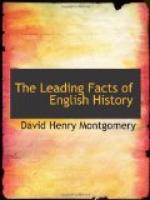Whatever William’s faults may have been, his great object was to build up a government better than any England had yet seen. Hence his severity, hence his castles and forts, by which he made sure of retaining his hold upon whatever he had gained.
112. William builds the Tower of London.
We have seen that William gave London a charter (S107); but overlooking the place in which the charter was kept, he built the Tower of London to hold the turbulent city in wholesome restraint. That tower, as fortress, palace, and prison, stands as the dark background of most events in English history.
It was the forerunner of a multitude of Norman castles. They rose on the banks of every river, and on the summit of every rocky height, from the west hill of Hastings to the peak of Derbyshire, and from the banks of the Thames to those of the Tweed. Side by side with these strongholds there also rose a great number of monasteries, churches, and cathedrals.
113. William confiscates the Land; Classes of Society.
Hand in hand with the progress of conquest, the confiscation of land went on. William had seized the lands belonging to Harold (S67) and those of the chief men associated with him, and had given them to his own followers in England. In this way, all the greatest estates and the most important offices passed into the hands of the Normans. The King made these royal grants on the express condition that those who received them should furnish him a certain number of armed men whenever he should demand them.
Two great classes of society now existed in England. First, the leading Norman conquerors, who, as chief tenants or landholders under the Crown, and as peers of the realm, had the title of barons. They numbered about fifteen hundred, and, as we have just seen, they were all pledged to draw their swordss in behalf of the King. Secondly, the English who had been reduced to a subordinate state; most of these now held their land as grants from the Norman barons on condition of some kind of service. A majority of these men were no longer entirely free, while some were actual slaves. The greater part of this servile class were villeins or farm laborers (S150). They were bound to the soil, and could be sold with it, but not, like the slaves, separately from it. They could be compelled to perform any menial labor, but usually held their plots of land and humble cottages on condition of plowing a certain number of acres or doing a certain number of days’ work in each year. In time the villeins generally obtained the privilege of paying a fixed money rent, in place of labor, and their condition gradually improved.
114. How William distributed his Gifts.
Yet it is noticeable that when William granted estates to his Norman followers (S113), he was careful not to give any baron too much land in any one county or shire. His experience in Normandy had taught him that it was better to divide than to concentrate the power of the great nobles, who were often only too ready to plot to get the crown for themselves.




